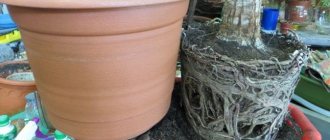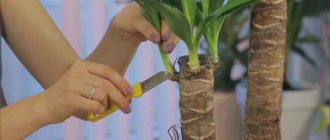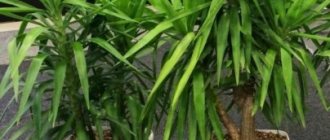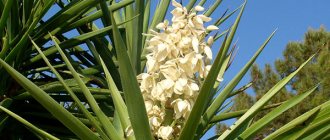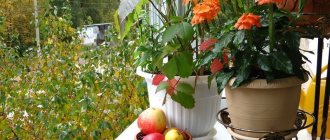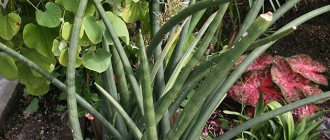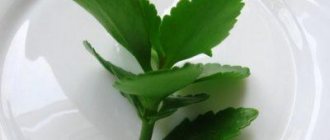What makes yucca unique?
Perhaps you have come across elephant yucca in offices, shops and shopping centers? Like any indoor flower, the small false palm has its own unique properties.
Its trunk is strong and thick, brown in color, and the higher it is, the greener it becomes.
Although it is not poisonous, if a child swallows a piece of the leaf, it can cause weakness and stomach upset. In addition, it releases phytoncides that cause allergies in sensitive people. It’s worth taking this into account when deciding where it’s best to put it: in the children’s room or living room.
What conditions does the Tropicana accept and how easy is it to care for it?
Types and varieties
There are over thirty different species of Yucca. They differ mainly in leaves and sizes. Some species have lanceolate leaves, while others have sword-shaped leaves. In addition, the edges of the leaf blades in some species are covered with long, stiff hairs, in others - with spines, and in others they are smooth. In addition to the usual green leaves, indoor varieties of Yucca have variegated leaves with bright white or yellow stripes. The most popular types: filamentous, ivory, gray, glorious and aloel.
At home, mainly two types are grown - ivory and aloe vera. Less often - filamentous and blue. We are sure that all types of this plant will decorate your home. Let's get to know them better.
Yucca elephantipes
It is named so because of the wide, massive base of the stem, which appears in Yucca in old age, which resembles the foot of an African elephant. This species of Yucca is very unpretentious to living conditions. It grows slowly. It is accustomed to the arid climate of a city apartment, is undemanding to the soil composition and does not take up much space in the room. In addition, other indoor flowers that are resistant to dry soil, for example, indoor Geranium or decorative Kalanchoe, can be planted in a wide pot with Yucca. Against the background of Yucca, pots with Anthurium, Spathiphyllum, and Benjamin ficus look great. Dollar or Money trees will also decorate this floral arrangement.
This may be interesting: Myrtle - home care
Yucca filamentous
In the south of Russia, in Crimea and the Caucasus, it grows in open ground and does not require shelter for the winter. In central Russia it is grown with shelter. Sometimes grown at home. This almost stemless plant grows as a shrub with beautiful bluish-green leaves, which have characteristic white or yellow stripes. The length of the leaves reaches 70 cm, width – up to 4 cm. The apex is pointed. The edges of the leaves are slightly drooping and contain numerous twisted white threads. The root system is well developed. The peduncle is very large, rising above the rosette to a height of up to one meter. Yucca blooms with drooping yellowish-white flowers up to 8 cm in length.
Yucca aloelia Marginata
This species is less common in indoor floriculture. It is more demanding in terms of content and takes up more space. It grows slowly, but over time, as it grows, the adult plant takes the shape of a ball with wide, leathery leaves. In the summer, Yucca Marginata blooms. On an inflorescence up to 45 cm long, many bell-shaped flowers of a creamy white color with a light purple tint are formed.
Yucca glauca
This type of Yucca has a greatly shortened stem. It does not grow higher than two meters in height. The bluish-green leaves are collected in dense rosettes about 90 cm wide. They are leathery, fibrous, up to 60 cm in length. At the edges they are white or gray with flaking fibers. In summer, it forms a paniculate inflorescence up to one meter in height, on which many small creamy-white flowers with a greenish or brown tint appear.
Temperature
In summer, the optimal temperature for the flower should be +23-26 °C. In winter, it enters a dormant period, so +15-18 °C will be comfortable for it, and with a lack of light, the temperature can drop to +10 °C. But we do not allow temperatures below +8, and in summer above +30 °C.
In winter, when I ventilate the room, I try to put the flower pot in a place where drafts will not reach it.
Yucca that stands near the window should not touch the glass, otherwise the leaves will begin to freeze. Hot radiators also pose a threat to leaves. In short, sudden temperature changes lead to stress on the palm tree.
However, an adult, strong yucca surprises with its ability to courageously endure sharp daily fluctuations. For example, if the temperature briefly rises to +35 °C, and at night drops to +8, she calmly tolerates it. A true native of the humid subtropics!
Features of care
Yucca elephantis: how to care? The plant is quite hardy . When creating comfortable conditions for growth, it easily adapts indoors. The main thing is that the yucca develops well, provide it with constant access to fresh air and regular watering. Drafts can have a detrimental effect on the false palm, so before ventilating the room it is moved to a protected place.
Most indoor plants are purchased in specialized stores, so after purchase the yucca needs to be replanted. This is due to the fact that before sale the plants are placed in pots intended for transportation. They are not suitable for long-term maintenance of palm trees.
Moreover, many manufacturers use special hormones that are implanted into the root system of the Elephant Foot. At home, her rapid exhaustion will begin.
Lighting
Yucca Elephant's foot prefers sunlight . Therefore, at home it should be placed on eastern or western windows, shading it from the bright rays of the midday sun.
With the onset of winter , when there is not enough sunlight, it is recommended to use fluorescent lamps. They are placed half a meter from the palm leaves. Artificial lighting should be used for at least sixteen hours a day. In summer, Yucca Elefantis is placed on a balcony or loggia.
Temperature
In summer, the optimal temperature should be from 22 to 25 degrees Celsius. In winter, it needs to be provided with cooler conditions in the range of 12 to 16 degrees.
False palm is poorly affected by sudden temperature changes . The plant may get sick.
The balance of lighting and air temperature must be stable, otherwise the leaves will become pale and lose their strength. When the air is hot in winter without proper lighting, the leaf plates become thin, their rigidity is lost and they begin to sag. At the same time, the shoots are greatly stretched.
Air humidity
Yucca Elefantis prefers moist air , and there is no need to spray it. To ensure the leaves are decorative, it is best to regularly wipe them with a damp sponge or wash them with warm water.
In winter, when the air in the room is dry due to operating heating devices, the container with the flower can be placed in a tray, where wet expanded clay, pebbles or moss must first be placed. This helps increase humidity.
How to water
Successful cultivation of yucca lies in proper care. First of all, this is ensuring proper watering at different times of the year . In summer it should be plentiful. In this case, it is necessary to monitor the condition of the substrate in the pot. As it dries to a depth of no more than five centimeters, the false palm tree is watered. This is done at the rate of 1.5 liters of water per five liters of soil volume.
In autumn and winter, watering is reduced, otherwise, with constant waterlogging, the roots will begin to rot, which will lead to the death of the flower. The water must first be settled, its temperature should be at room temperature.
Flowering period
Almost all types of yucca are flowering, however, it never blooms indoors . In order for flower buds to be formed, the plant needs a long period of cold wintering.
You can see how elephant yucca blooms in natural conditions here.
Implementation of fertilizing
For Yucca Elefantis, feeding is very important . The plant reacts positively to them. Fertilizers are applied with the onset of spring and during the summer once every twenty days.
After transplantation or after illness, the false palm tree does not need to be fed for some time.
Yucca responds best to fertilization with mullein, leaf humus and horse manure. For good plant growth, complex mineral fertilizers are used.
How to replant a false palm
Yucca Elefantis needs well-drained soil , so you need to replant the plant in a high container, at the bottom of which a drainage layer of three or five centimeters is placed. Old soil is washed away from the roots. To do this, the yucca needs to be placed in a container of water for one hour.
The acidity of the soil for the plant should be neutral, so the soil can be bought in the store, and it should be chosen specifically for palm trees, dracaenas or cacti.
It is not difficult to prepare your own soil mixture . To do this, mix one part of humus, two parts of quartz sand, two parts of leaf and turf soil.
The yucca is buried no more than three centimeters into the new pot, which will give it stability and prevent the stem from rotting.
Priming
Yucca does not like stagnant moisture. Therefore, its main requirement for the soil is that water should not linger and pass through in transit.
The acid-base balance of the earth does not play a special role - yucca is not picky.
Like real gardeners, let's prepare the soil mixture ourselves. Pour drainage into the bottom of the container, about ¼ of it. We prepare the soil from three parts:
- sand;
- compost;
- leaf humus.
If we don’t have all the ingredients, we go to the nearest flower shop and buy soil for palm trees or dracaenas.
Growing from seeds
In recent years, you can increasingly find yucca seeds in flower shops, but, according to experts in the field of false palm cultivation, it is not recommended to grow such an ornamental crop from seeds. Plants obtained by seed propagation do not have sufficient frost resistance and freeze out when cultivated in open ground.
In the Moscow region, it will not be possible to obtain your own yucca filamentous seeds due to the lack of moths that pollinate the tropical crop. Of course, as an experiment, you can sow yucca seeds in a nutritious soil substrate in early spring or mid-autumn, but you must remember that with such propagation it is not always possible to obtain seedlings. A mixture based on drainage, leaf soil and coarse sand in equal proportions is optimal for sowing seeds. The crops need to be covered and placed in a place with good lighting and a temperature of 20°C. Shoots appear in about four weeks.
Watering
Improper watering is the only thing that can threaten the health of the yucca.
I try to pour so that the lower part of the soil, where the bulk of the roots are located, is always wet. Therefore, I water until water begins to flow out of the holes.
How can you tell when it’s time to water the plant? When the soil in the upper part of the pot dries out by one third, I go to water the flower. Depending on the air temperature, this takes from 2 to 4 days. I do not immediately drain the water that flows into the pan, but after 20 minutes.
In general, yucca does not tolerate stagnation of water and long drying, so sometimes it is important to let it dry out even two-thirds of the ground.
For her, this is so important that if after 3-4 days we see that the soil has not yet dried out, we take the initiative into our own hands and loosen the soil.
Important
The smaller the volume of the pot, the more often you have to water it, and the larger it is, the less often.
Lighting
Yucca loves good lighting . Its leaves are covered with a thin layer of waxy coating; they are dense, tough and perfectly adapted to all kinds of living conditions. Therefore, she is not afraid of even the brightest sunlight. In summer it can withstand even the brightest sun provided there is good aeration, i.e. sufficient supply of fresh air.
In winter, lighting depends on temperature .
Temperature
In summer, the air temperature can be almost any : yucca tolerates temperatures above 30, especially in the fresh air or in a well-ventilated area.
Rest period
In winter, yucca needs coolness for at least 2 months. This is not a slight drop in temperature, but rather cool conditions, +5 - +8°C.
With such maintenance, lighting does not play - the plant is at rest and does not grow .
This period is very important for development - flower buds are laid. With such content, additional lighting may not be necessary.
If it is not possible to arrange a cool winter, then it is necessary to provide the plant with as much natural and artificial light as possible, otherwise it will stretch, bend the trunk and fade.
When grown in the garden, yucca sometimes requires shelter for the winter. The yucca is wrapped in several layers of thick paper or cardboard, the packaging is secured, and the ground around is mulched with sawdust, straw, or insulated with spruce branches.
In areas where the winter temperature drops below -10°C , it is advisable to grow yucca year-round in a pot, taking it outside during the warm season.
Air humidity
Yucca tolerates dry indoor air, but atmospheric moisture has a positive effect on its appearance and well-being, especially at high temperatures.
Watering
In the warm season, with active growth, you need to water abundantly , but not often. Moisten the soil for yucca in a pot only after the earthen clod has completely dried out.
IMPORTANT! When water stagnates, fungi and algae very quickly settle in the soil, to which yucca is sensitive.
during the dormant period is even more dangerous . At this time, there is a high risk of root rotting. In the cool winter, yucca is watered very rarely and very little at a time so that the roots do not dry out. This is exactly the case when it is better to underfill than overfill.
Transfer
I replant yucca once a year or as needed. It is important to choose the right pot. It must be quite large, otherwise the roots will not support the massive crown and leaf mass. The plant may not stand and fall over.
Don't worry if the roots wrap around the entire soil ball. This does not mean that you missed the time of replanting, it’s just that the yucca’s root system is structured this way.
By the way, if you don’t want your yucca to grow, you can stop it from growing. Just trim the roots and plant back in the same pot.
Reproduction
It is very easy to propagate yucca from cuttings:
- cut a cutting from an adult plant;
- dry it in the shade for about 12 hours;
- place in moist soil;
- when roots appear, transplant it into a pot with soil.
There is also a method of reproduction through circumcision. For example, our palm tree has grown and we decided to shorten it. A couple of days before cutting the top, water the yucca generously. We cut off the top of the palm tree and root it in water or damp soil. It is best to do this in the spring, when the plant is just waking up.
Description of the plant
The yucca palm, growing in pots at home, belongs to the Agave family. It is a perennial, evergreen and tree-like plant. Yucca grows quite slowly and indoors can reach only 4 m. A yucca plant at home can bloom with large luxurious flowers, but in the middle zone it does not bear fruit. Flowering can be achieved if you keep it on an open veranda or balcony in the summer.
Externally, yucca is similar to a palm tree; it has a round, powerful trunk and large, strong leaves, narrow and pointed, arranged in the form of a fan or collected in a rosette.
The leaves are usually a uniform, rich green color; they rarely have light veins. The length of one leaf can vary from 50 to 100 cm. If the yucca blooms, it produces flowers in the form of white bells. The inflorescence of buds looks like a panicle and comes out from the middle of the leaf rosette.
Yucca (Yucca Elephant). Unpretentious, Exotic and Pleasant in Every Respect
How to feed yucca
We feed the flower as desired in spring and summer. Twice a month from April to September I water with a special liquid fertilizer Kemira, it is intended for palm or decorative deciduous species.
Honestly, yucca is so unpretentious that it grows even in poor soil, but of course, if you feed it, the plant will be even better.
In the autumn-winter period there is usually no need for fertilizing. Also, you should not feed the flower for the first 3-4 weeks after transplantation.
Pests and diseases
Yucca is almost never sick, but if brown spots appear on its leaves, there are good reasons for this, for example:
- waterlogging;
- hypothermia of roots,
- frequent overflows;
- lack of air to the roots due to poor drainage;
- poor soil drying;
- too acidic soil;
- increased alkalinity.
Due to any of the above problems, a fungal disease appears, but the essence is the same - yucca is a drought-resistant plant and excessive moisture is harmful to it.
If the plant is already suffering, how to stop it?
Control measures are simple: remove the affected leaves, water the plant with a fungicide. We also reduce watering and spraying. We move the palm tree to where there is more light.
Why does yucca turn yellow and how to save it, watch the video:
Errors in care and their consequences
If yucca leaves have lost their decorative appearance, this is not always a signal of disease or pest damage. Much more often this happens due to mistakes in care that the grower makes.
The most common problems and their causes are shown in the table.
| Nature of leaf damage | Probable Cause |
| The ends dry out | Lack of fresh air Low humidity |
| Became soft | Excessive watering |
| Darkened and twisted | Temperature too low |
| Light spots have appeared | Sunburn |
| Have turned yellow and are falling off | The plant is in a draft Temperature is too low |
| Brown spots appeared | Drying of the earthen coma |
The gradual yellowing and death of the lower leaves of the plant is a natural process. It is thanks to him that it acquires its unusual appearance.
The only sign of yucca disease or improper care is the active yellowing of all leaves and the absence of new ones.
Usually it is enough to simply correct care errors. For example, if a flower is flooded and the leaves droop, there is no need to immediately destroy the earthen ball and wash the roots with fungicides.
It is necessary to inspect them for the presence of rot. Healthy yucca roots are white and juicy. Rotten - brownish, thinned, easily peeling off. If there are no such signs, it is enough to plant the plant in dried soil and do not flood it again.
